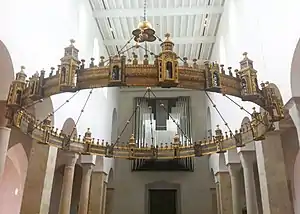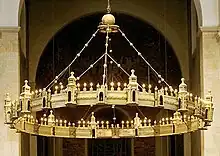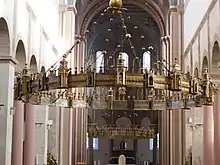Hezilo chandelier
The Hezilo chandelier (German: Heziloleuchter) is an 11th-century Romanesque wheel chandelier. It is part of the treasures of the Hildesheim Cathedral in Hildesheim, Germany, which has been a UNESCO World Cultural Heritage site since 1985. The chandelier was most likely commissioned by Bishop Hezilo of Hildesheim, who rebuilt the cathedral after a fire. He probably also influenced the program of imagery and inscriptions. It is the largest of four extant wheel chandeliers of the period; the others surviving examples are the Azelin chandelier (also in Hildesheim), the Barbarossa chandelier in the Aachen Cathedral, and the Hartwig chandelier in the Abbey of Comburg.
| Hezilo chandelier | |
|---|---|
 The Heziloleuchter above the Hildesheim Cathedral nave, in 2014 | |
| Year | Eleventh century |
| Type | Romanesque art |
| Medium | Gilt copper |
| Dimensions | 600 cm (240 in) |
| Location | Hildesheim, Germany |
| 52.1489°N 9.9464°E | |
During the restoration of the cathedral (from 2010 to 2014), the chandelier was installed in St. Godehard, a basilica since 1963 and the temporary bishop's seat. After the restoration of the cathedral, which reopened on 15 August 2014, it was returned to its original location in the cathedral's nave.
Description

The Hezilo chandelier is composed of a circular hoop which is 6 metres (20 ft) in diameter. The hoop is made of gilt copper and bears Latin inscriptions on the upper and lower edges. Between the inscriptions are three horizontal bands, with the middle band bulging outwards, which are richly decorated with openwork foliage. There are square merlons on top of the hoop holding seventy-two candles.[1]
Twelve towers and twelve gate-houses alternate along the outside of the hoop. The layout of the towers is a Greek cross with four apses (alternately rounded with domed roofs and square with pitched roofs) and a doorway. The upper parts of the towers have a narrower form, extending above the candles on the hoop and topped with large balls. Small statues or lamps probably originally stood inside these towers.
The gatehouses are flat, no higher than the hoop and are closed at the rear - where the ropes which hold up the chandelier are anchored. Each gate is flanked by two small but richly decorated round turrets and is crowned with battlements and the name of an apostle. It is likely that there were once images of these apostles in the doorways.
In the center, a large lamp is hung from a rope. The chandelier, also called a corona (crown) or circular chandelier,[1] hung in the nave until 1944, when it was removed to protect it from bombing. It hung above the altar in the crossing from the reopening of the cathedral in 1960 to 2010, when cathedral restoration work began.[2]
History
Bernward, Bishop of Hildesheim, gifted the first large wheel chandelier to the Hildesheim Cathedral built by Bishop Altfrid, and later also gave one to the adjacent church of St. Michael.[3] After Altfrid's cathedral burned down in 1046, Bishop Hezilo had it rebuilt with alterations, rejecting the plan of his predecessor Azelin to build a new cathedral, and in the nave he hung a "crown chandelier of shimmering gold", which is now known by his name as the Hezilo chandelier.[4] It is not clear what influence the earlier chandelier of Bernward had on the design of this replacement.[5]
Symbolism
The model for a chandelier as the symbol of the New Jerusalem was the great wheel chandelier in the Church of the Holy Sepulchre above Golgotha; the Azelin chandelier was designed to have the same symbolism.[6] Elements of Islamic art in the ornamentation of the chandelier support the identification with Jerusalem.[7]
The idea of the chandelier is the image of a floating city: according to the inscription, the Heavenly Jerusalem as target of the old and new covenants, fragrant with the scent of virtue, populated by the saints, lit by God himself, the source of all light.
— Bertram, p. 117
The Hezilo chandelier was at the liturgical center of the cathedral until the nineteenth century, with services held under its crown of light. Its location marked the beginning and end of the great processions of the cathedral chapter on Sundays and holidays. The chandelier served as a symbol of righteousness. Violations of the sovereignty of the diocese were solemnly resolved beneath it.[8]
Restoration

Restoration work was carried out in the 16th century and again at the beginning of the 19th and 20th centuries, During the Second World War, the Hezilo chandelier was dismantled and removed from the cathedral — which was virtually destroyed by Allied bombing in March 1945. After the cathedral was rebuilt during the 1950s, the 900-year-old chandelier was placed in the crossing. It underwent extensive conservation work from 2002 until 2007.[2] In 2010, when restoration work on the cathedral began, it was moved to St. Godehard, a Romanesque church in Hildesheim and the temporary seat of the bishop.
Inscription
Due to early modern restorations, the verse inscription has been significantly altered. The donor's name, "Hezilo" was written in a later script. The oldest version is in a manuscript from around 1500:
| Latin | English |
|---|---|
URBS EST SUBLIMIS MIRIS FABRICATA FIGURIS |
The city on high is built with amazing shapes, |
MATER IVSTITIAE VIA VITAE GRATIA CVLPE |
Mother, path of Justice, in thanks for life, |
Bibliography
- Willmuth Arenhövel. Der Hezilo-Radleuchter im Dom zu Hildesheim: Beiträge zur Hildesheimer Kunst des 11. Jahrhunderts unter besonderer Berücksichtigung der Ornamentik. Mann, Berlin 1975, ISBN 3-7861-4099-5.
- Norbert Bergmann. "Der Hezilo-Leuchter – Eine Systemanalyse und ihre Folgen," in Ursula Schädler-Saub (ed.), Weltkulturerbe Deutschland. Präventative Konservierung und Erhaltungsperspektiven, internationale Fachtagung des Deutschen Nationalkomitees von ICOMOS. Hildesheim, 23.–25. November 2006. Regensburg 2008
- Adolf Bertram. Geschichte des Bisthums Hildesheim, Vol. I, Hildesheim 1899, pp. 116f & 120f.
- Bernhard Gallistl. "Bedeutung und Gebrauch der großen Lichterkrone im Hildesheimer Dom" in Concilium medii aevi 12, 2009, pp. 43–88, online: (PDF; 2,9 MB). Retrieved 18 January 2012
- Ulrich Knapp, Karl Bernhard Kruse. Der Hezilo-Leuchter im Hildesheimer Dom. Schnell und Steiner, Regensburg 2013, ISBN 978-3-7954-2755-9
- Ch. Wulf (ed.). Die Inschriften der Stadt Hildesheim. Ges. und bearb. von Ch. Wulf. Wiesbaden 2003, (Die deutschen Inschriften 58). vol 2. pp. 213–216
References
- Julia de Wolf Addison: Arts and Crafts in the Middle Ages Archived 2014-05-03 at the Wayback Machine Medieval Histories
- Gallistl, p. 43
- Vita Bernwardi c.8
- Gallistl, pp. 45–46
- Martina Giese, Die Textfassungen der Lebensbeschreibung Bischof Bernwards von Hildesheim. (MGH Studien und Texte 40), Hannover 2006, ISBN 3-7752-5700-4, p. 114
- Der Thietmarleuchter Weltkulturerbe in Niedersachsen. Retrieved 9 May 2014
- Sabine Noack-Haley, "Islamische Elemente am Hezilo-Leuchter im Mariendom zu Hildesheim" in Martina Müller-Wiener, Al-Andalus und Europa. Imhof, Petersberg 2004, ISBN 3-935590-77-6, pp. 197–204.
- Gallistl, pp. 49–53
- Gallistl, p. 44
External links
- The Hezilo-candlesticks in: Restoration of the World Cultural Heritage Hildesheim Cathedral